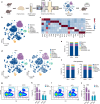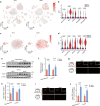SGK1 drives hippocampal demyelination and diabetes-associated cognitive dysfunction in mice
- PMID: 39962079
- PMCID: PMC11833069
- DOI: 10.1038/s41467-025-56854-2
SGK1 drives hippocampal demyelination and diabetes-associated cognitive dysfunction in mice
Abstract
Diabetes-associated cognitive dysfunction (DACD) is increasingly recognized as a critical complication of diabetes. The complex pathology of DACD remains unknown. Here, we performed single-nucleus RNA sequencing (snRNA-seq) to demonstrate unique cellular and molecular patterns of the hippocampus from a mouse model of diabetes. More in-depth analysis of oligodendrocytes (OLs) distinguished five subclusters, indicating different functional states of OLs and transcriptional changes in each subcluster. Based on the results of snRNA-seq and experiments in vivo, we observed demyelination and disharmony of oligodendroglial lineage cell composition in male diabetic mice. Serum/glucocorticoid regulated kinase 1 (SGK1) expression was significantly increased in the hippocampus OLs of male diabetic mice, and SGK1 knockdown in hippocampus reversed demyelination and DACD via N-myc downstream-regulated gene 1 (NDRG1)-mediated pathway. The findings illustrated a transcriptional landscape of hippocampal OLs and substantiated impaired myelination in DACD. Our results provided direct evidence that inhibition of SGK1 or the promotion of myelination might be a potential therapeutic strategy for DACD.
© 2025. The Author(s).
Conflict of interest statement
Competing interests: The authors declare no competing interests.
Figures









Similar articles
-
Sgk1 regulates desmoglein 1 expression levels in oligodendrocytes in the mouse corpus callosum after chronic stress exposure.Biochem Biophys Res Commun. 2015 Aug 14;464(1):76-82. doi: 10.1016/j.bbrc.2015.05.109. Epub 2015 Jun 1. Biochem Biophys Res Commun. 2015. PMID: 26043694
-
Inhibition of GZMB activity ameliorates cognitive dysfunction by reducing demyelination in diabetic mice.Free Radic Biol Med. 2024 Nov 20;225:53-62. doi: 10.1016/j.freeradbiomed.2024.09.041. Epub 2024 Sep 24. Free Radic Biol Med. 2024. PMID: 39326683
-
Plasma corticosterone activates SGK1 and induces morphological changes in oligodendrocytes in corpus callosum.PLoS One. 2011;6(5):e19859. doi: 10.1371/journal.pone.0019859. Epub 2011 May 31. PLoS One. 2011. PMID: 21655274 Free PMC article.
-
DNMT3b-mediated CpA methylation facilitates REST binding and gene silencing and exacerbates hippocampal demyelination in diabetic mice.J Biol Chem. 2025 Feb;301(2):108137. doi: 10.1016/j.jbc.2024.108137. Epub 2024 Dec 25. J Biol Chem. 2025. PMID: 39730060 Free PMC article.
-
Mechanistic insights into the role of serum-glucocorticoid kinase 1 in diabetic nephropathy: A systematic review.Int J Biol Macromol. 2021 Dec 15;193(Pt A):562-573. doi: 10.1016/j.ijbiomac.2021.10.165. Epub 2021 Oct 26. Int J Biol Macromol. 2021. PMID: 34715204
Cited by
-
Metformin Activation of Sirtuin 3 Signaling Regulates Mitochondrial Function Improves Diabetes-Associated Cognitive Impairment.Diabetes Metab Syndr Obes. 2025 Jul 12;18:2317-2330. doi: 10.2147/DMSO.S516173. eCollection 2025. Diabetes Metab Syndr Obes. 2025. PMID: 40672059 Free PMC article.
References
-
- Kullmann, S. et al. Brain insulin resistance at the crossroads of metabolic and cognitive disorders in humans. Physiol. Rev.96, 1169–1209 (2016). - PubMed
MeSH terms
Substances
Grants and funding
- 82000771/National Natural Science Foundation of China (National Science Foundation of China)
- 82401487/National Natural Science Foundation of China (National Science Foundation of China)
- 82288101/National Natural Science Foundation of China (National Science Foundation of China)
- 2024M762178/China Postdoctoral Science Foundation
- ZR2021MH043/Natural Science Foundation of Shandong Province (Shandong Provincial Natural Science Foundation)
LinkOut - more resources
Full Text Sources

